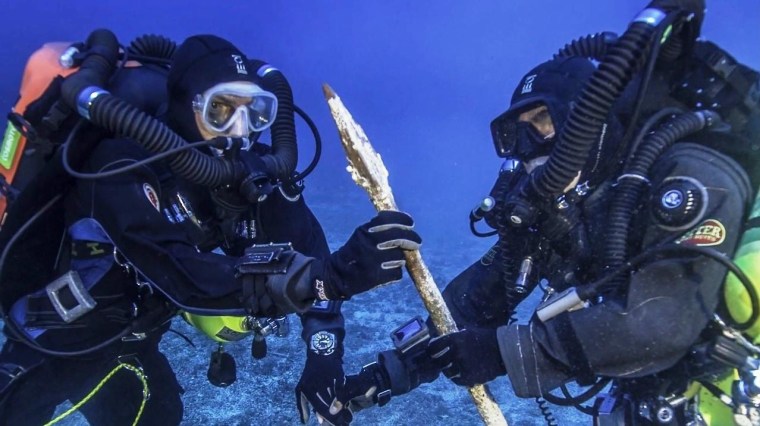Ancient tableware, lead anchors and a giant bronze spear have been recovered during an expedition to the 2,000-year-old Antikythera shipwreck in Greece.
The treasure-filled sunken ship was first discovered more than a century ago. Now, undersea excavators who are revisiting the wreck say it actually covers a much bigger area than expected.
"The evidence shows this is the largest ancient shipwreck ever discovered," Brendan Foley, a marine archaeologist from the Woods Hole Oceanographic Institution in Massachusetts, said in a statement. "It's the Titanic of the ancient world." [In Photos: Mission to 2,000-Year-Old Antikythera Shipwreck]
Over the past few weeks, Foley and his colleagues used a suite of high-tech equipment — including a semi-robotic Exosuit — to explore the famed Antikythera wreck.
The ship sank sometime between 70 B.C. and 60 B.C. on its way from Asia Minor to Rome. Sponge fishermen found the wreck in 1900 off the coast of Antikythera, a small Greek island positioned along an ancient shipping route.
Those divers salvaged statues of heroes and horses, jewelry, furniture, glassware and the Antikythera mechanism, a complex astronomical calculator. But exploring the site, 180 feet (55 meters) below the surface, proved dangerous. One diver died of the bends and two were left paralyzed, according to WHOI.
Jacques Cousteau found more tantalizing objects when he revisited the Antikythera wreck decades later. To find out what else might be buried beneath the seafloor, Foley and the Greek Ministry of Culture conducted underwater excavations from Sept. 15 to Oct. 7.
WHOI said high-resolution 3-D maps suggest that the wreckage might span 984 feet (300 meters) of the seafloor, and that the ship was perhaps up to 164 feet (50 meters) long.
Divers recovered multiple lead anchors and a bronze rigging ring with bits of wood still attached. An intact table jug, a piece of an ornate bed leg and a 6.5-foot-long (2-meter-long) bronze spear were buried in the sediment. The spear may be part of a statue of a warrior or the goddess Athena — or perhaps part of a larger warrior-and-chariot sculpture, Foley said.
The team plans to return next year for further excavations.
— Megan Gannon, LiveScience
This is a condensed version of a report from LiveScience. Read the full report. Follow Megan Gannon on Twitter and Google+. Follow LiveScience on Twitter, Facebook and Google+.
